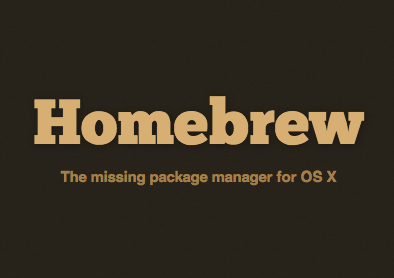After installing homebrew's openssh on El Capitan, ssh-agent no longer seemed to work (in the sense that after using ssh-add to cache a passphrase, I still got a system prompt when trying to ssh). This seemed to be fixed by the instructions I found at the url below (my version is functionally the same but uses PlistBuddy to edit the plist). Homebrew complements macOS (or your Linux system). Install your RubyGems with gem and their dependencies with brew. “To install, drag this icon” no more. Homebrew Cask installs macOS apps, fonts and plugins and other non-open source software. $ brew install -cask firefox. Making a cask is as simple as creating a formula.
Welcome to the Treehouse Community
The Treehouse Community is a meeting place for developers, designers, and programmers of all backgrounds and skill levels to get support. Collaborate here on code errors or bugs that you need feedback on, or asking for an extra set of eyes on your latest project. Join thousands of Treehouse students and alumni in the community today. (Note: Only Treehouse students can comment or ask questions, but non-students are welcome to browse our conversations.)
Looking to learn something new?
Treehouse offers a seven day free trial for new students. Get access to thousands of hours of content and a supportive community. Start your free trial today.
I have uninstalled homebrew but now it keeps telling me that is is still installed, I am 100% sure that is is uninstalled because when I run the brew command it does not work.
This is the message I keep getting:
It appears Homebrew is already installed. If your intent is to reinstall youshould do the following before running this installer again: ruby -e '$(curl -fsSL https://raw.githubusercontent.com/Homebrew/install/master/uninstall)'The current contents of /usr/local are bin Cellar CODEOFCONDUCT.md CONTRIBUTING.md etc git heroku include lib Library LICENSE.txt opt README.md share SUPPORTERS.md var .git .gitignore
Posting to the forum is only allowed for members with active accounts.
Please sign in or sign up to post.
The easiest way to install a number of Unix style applications and open source software onto macOS Big Sur, Catalina, Mojave and earlier Sierra OS versions is via a package manager, unfortunately, macOS Big Sur doesn’t come with one, but fortunately, some good folks care, they come in the form of Homebrew.
The install of Homebrew also works on macOS Catalina, macOS Mojave, (High)Sierra, El Capitan, and Yosemite, so macOS 10.10 – 10.14
Homebrew isn’t the only option, also available is MacPorts and Fink but Homebrew is the newest and most popular of the trio.
Install Homebrew
To download install Homebrew run the install script on the command line as below and let the script do its thing:
If you don’t have Apples Xcode Command Line Tools installed it will alert you to that it will install it and carry on with the Homebrew installation and download the Command Line Tools you will need to enter your admin password at some point.
Then Homebrew is installed.
After this Homebrew is installed and ready to install other apps.
To get started run brew help can give some command example usage.
To check for any issues with the Homebrew install run: Kingdom rush pc trainer.
One issue that typically comes up is an outdated or missing version of Xcode.
For the latest macOS, brew doctor will warn that the Homebrew install won’t be 100% if Xcode is not up to date, so update Xcode from the App Store.
To search for an application:
To install
To list all apps installed by Homebrew

To remove an installed application

To update Homebrew itself
Monopoly classic full version free download. To see what packages are out of date but not to upgrade them

To see what upgrade packages all or singular
To hold a package at a certain version
To release a package from a certain version
To see what else you can do
Where does Homebrew install stuff …. in the Cellar
Where the brew lives.
You can see your Homebrew configuration by running
The output should be similar to …
All installations via Homebrew are filed independently in the filing system in /usr/local/Cellar and linked into /usr/local/bin which is a directory which allows you to run these commands and apps as if part of the regular operating system.
This directory is also out of the SIP bounds so there should be no authentication macOS error dialog boxes.
Remove Home-brew and all packages
Homebrew El Capitan
To remove the Home-brew installation and all packages it has installed.
Homebrew El Capitan Download
HomeBrew is a great package manager just start installing some apps and explore.!